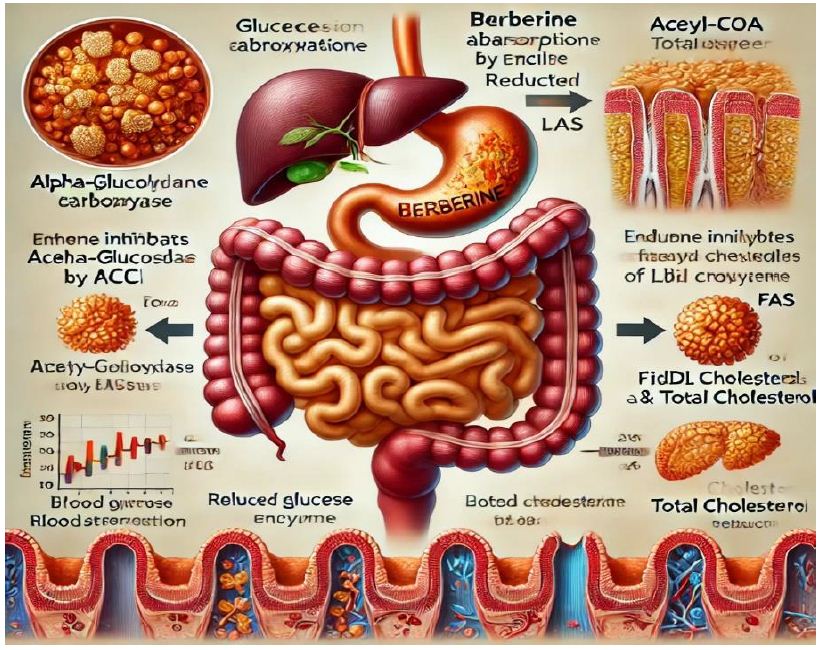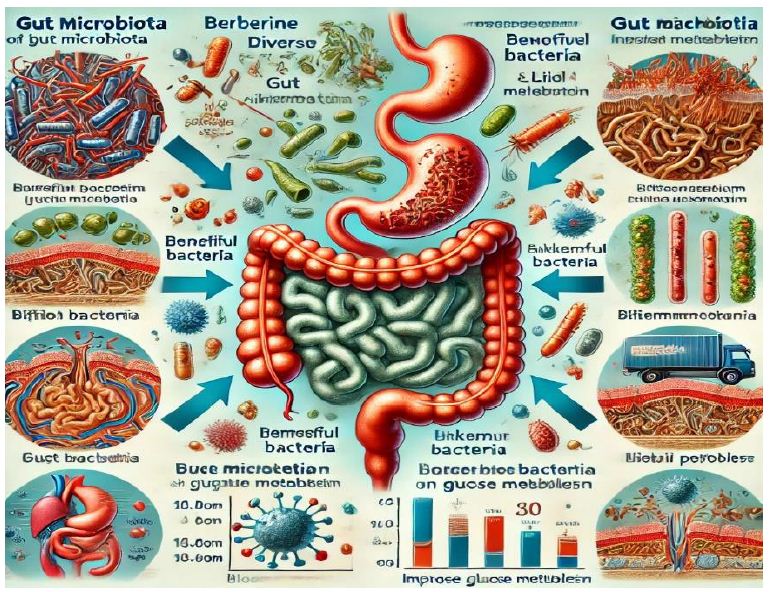Abstract
Berberine is a bioactive compound with a broad spectrum of pharmacological activities. Berberine has gained significant attention for its ability to manage Type 2 Diabetes Mellitus. It significantly reduces fasting blood glucose levels, glycated hemoglobin HbA1c, and postprandial blood glucose levels in patients with T2DM, with efficacy comparable to that of metformin. It exerts its antidiabetic effects via activation of AMP-activated protein kinase, improvement of Insulin Sensitivity, reduction of Intestinal Glucose Absorption and modulation of gut microbia, anti-inflammatory and antioxidant effects.
Keywords
Berberine, Type 2 Diabetes Mellitus, Glucose, Anti-inflammatory effects, Antioxidant effects
Introduction
Berberine is a bioactive compound found in several plants, including Berberis species (e.g., Berberis vulgaris or barberry) (Figure 1). It is traditionally used in Chinese and Ayurvedic medicine for its antimicrobial, anti-inflammatory, and antidiabetic properties. Recent research has concentrated as a therapeutic agent for Type II Diabetes Mellitus (T2DM) due to its ability to modulate glucose and lipid metabolism [1-6].

Figure 1: Berberine molecule
Berberine is renowned for its broad spectrum of pharmacological activities, including:
Antimicrobial activity: Berberine is effective against microorganisms, bacteria, viruses, fungi and protozoa. It can fight bacterial infections, especially those caused by Staphylococcus aureus and Escherichia coli [7-10].
Anti-inflammatory effects: Berberine works by lowering the induced oxidative stress by inhibiting the production of pro- inflammatory cytokines (TNF-α, IL-6). Oxidative stress represents a disturbance in the balance between the production of reactive oxygen species (Reactive Oxygen Species) and the ability of a biological system to inactivate these toxic molecules and fix the injury they cause. Reactive oxygen species harm all cell elements, as well as proteins, lipids, and DNA. The main antioxidant shields accessible to the cell are: Superoxide dismutase (SOD), Catalase and Glutathione peroxidase. Arthritis and inflammatory bowel disease are two examples of diseases that benefit from berberine administration. Modification of gut microbiota composition appears to be involved in gastrointestinal health [2,14].
Cardiovascular beneflts: Berberine acts by lessening blood pressure, cholesterol levels and at the same time improving endothelial function.
Anticancer potential: Research has shown that berberine possesses anticancer properties. It can initialize apoptosis (programmed cell death) in cancer cells, arrest cell proliferation, and subdue tumor growth in different types of cancer [4,13,17]. Some of the mechanisms with which Berberine inhibits cancer metastasis are shown in Figure 2.

Figure 2: Some of the mechanisms with which Berberine inhibits cancer metastasis.
Effects of Berberine on Diabetes
Berberine BBR has gained significant attention for its ability to manage Type 2 Diabetes Mellitus (T2DM). Clinical studies have shown that berberine significantly reduces fasting blood glucose levels, glycated hemoglobin HbA1c, and postprandial blood glucose levels in patients with T2DM, with efficacy comparable to that of metformin. Berberine not only lowers glucose levels but also improves lipid profiles by reducing triglycerides TG, LDL-cholesterol, and total cholesterol, making it a valuable treatment option for patients with both T2DM and dyslipidemia. In a study including thirty-six adults with T2DM, who took berberine or metformin 0.5 g, 3 times a day) in a 3-month trial, there was the same significant decrease in glucose, HbA1c, TG both with berberine and metformin [14]. Ninety-seven T2DM patients with T2DM were treated orally with BBR, 1 g/d for 2 months and it was found increased insulin sensitivity and decrease in glucose, HbA1c, TG [15].
In a double-blind randomized controlled placebo trial, eighty-four patients with T2DM were divided in 2 groups (42 each) and each group received Berberine capsules 500 mg or placebo twice daily for 4 weeks. In the BBR group, a statistically significant decrease in glucose levels was observed before and after the meal, while the decrease in LDL, TG, VLDL was not statistically significant [9,18]. Administration of BBR with plant polyphenols to T2DM patients for 90 days significantly reduced glycated hemoglobin, insulin, homeostatic model assessment of insulin resistance, total and low-density lipoprotein cholesterol, and triglycerides [3]. In a double-blind study including patients with Non-alcoholic steatohepatitis (a liver problem frequently associates with diabetes), BBR administration 1000 mg twice a day, caused a significant decrease in liver fat content and a significant decrease in glycemic and lipid indices in the group of patients with T2DM [5].
Mechanisms of Action
Berberine exerts its antidiabetic effects through several mechanisms:
- Activation of AMPK Pathway: One of the most critical mechanisms of berberine is the activation of AMP-activated protein kinase (AMPK), a crucial enzyme that regulates energy homeostasis in cells. Activation of AMPK leads to increased glucose uptake in peripheral tissues, enhanced fatty acid oxidation, and decreased lipid synthesis (Figure 3). This results in improved insulin sensitivity and reduced blood glucose levels. AMPK activation by berberine also inhibits hepatic gluconeogenesis (the production of glucose by the liver) and promotes glycolysis (the breakdown of glucose for energy), contributing to its antidiabetic effects [15,19].
- Improvement of Insulin Sensitivity: Berberine improves insulin sensitivity by reducing insulin resistance, a hallmark of T2DM. It does this by modulating key insulin signaling pathways, which helps in lowering fasting blood glucose levels and glycated hemoglobin (HbA1c) (Figure 4) (Yin et al,2008).
- Reduction of Intestinal Glucose Absorption: Berberine is an inhibitor of α-glucosidase, an enzyme responsible for the breakdown of glycogen in lysosomes. Binding to M6P receptors on the cell surface has been shown to occur via carbohydrate groups on the enzyme molecule, after which it is internalized and transported to lysosomes, where it undergoes proteolytic cleavage leading to increased enzyme activity for glycogen degradation [7]. It also inhibits acetyl- CoA carboxylase ACC and fatty acid synthase FAS inducing the activity of enzymes that promote lipolysis (Figure 5). This regulation results in lower levels of triglycerides, low-density lipoprotein (LDL) cholesterol, and total cholesterol, making berberine effective in managing dyslipidemia [1].
- Modulation of Gut Microbiota: The action of berberine includes its effect on the composition of the intestinal microflora (Figure 6). Increases bacteria such as Bifidobacterium, Akkermansia involved in glucose and lipid metabolism. It also reduces the population of bacteria involved in metabolic disorders and inflammatory reactions [16]. The changes in the intestinal microflora contribute to the antidiabetic and anti- obesity effect of the molecule.
- Anti-inflammatory and Antioxidant Effects: Chronic low- grade inflammation and oxidative stress are implicated in the pathogenesis of T2DM [8,11,12]. Berberine exhibits anti-inflammatory and antioxidant properties, which contribute to its protective effects against T2DM and its complications [2].

Figure 3: Berberine activates AMPK and effects on cellular metabolism. At the center, depict AMPK as a large protein complex with labels, showing it being activated by Berberine molecules attaching to it. Berberine molecules can be represented as small, yellow compounds binding to the AMPK complex.

Figure 4: Berberine regulates glucose and lipid metabolism by inhibiting enzymes involved in lipid synthesis and enhancing those promoting lipid catabolism.

Figure 5: How Berberine promotes lipolysis

Figure 6: Modulation of gut microbiota by berberine
Safety of Berberine
While metformin is a prescription medication, used as a standard treatment for type 2 diabetes, Berberine is available as a dietary supplement and is often used by individuals seeking natural alternatives or adjuncts to conventional treatments. It is generally well-tolerated, with gastrointestinal discomfort being the most commonly reported side effect. Its safety profile compares favorably with standard antidiabetic drugs, making it a promising alternative or complementary therapy.
Conclusions and Perspectives
Berberine exerts its pharmacological effects through multiple mechanisms, including AMPK activation, modulation of glucose and lipid metabolism, inhibition of glucose absorption, alteration of gut microbiota, and anti-inflammatory actions. These diverse mechanisms make berberine a promising therapeutic agent for managing Type 2 Diabetes Mellitus, cardiovascular diseases, and other metabolic disorders. Additionally, more methods or techniques should be developed to improve the bioavailability and antidiabetic activity of berberine. More clinical trials should be carried out to confirm effects of berberine on Diabetes and metabolic disorders.
Funding Statement
This research was not funded
Conflicts of Interest
The authors declare no conflict of interest.
References
- Brusq JM, Ancellin N, Grondin P, Guillard R, Martin S, Saintillan Y, Issandou M, et al. (2006) Inhibition of lipid synthesis through activation of AMP kinase: an additional mechanism for the hypolipidemic effects of berberine. Journal of Lipid Research 47(6): 1281-1288. [crossref]
- Chang W, Chen L, Hatch GM, Zhang Y (2015) Berberine as a therapy for type 2 diabetes and its complications: From mechanism of action to clinical studies. Biochemical Pharmacology 87(1): 42-52. [crossref]
- Di Pierro F, Villanova N, Agostini F, Marzocchi R, Soverini V, Marchesini G (2012) Pilot study on the additive effects of berberine and oral type 2 diabetes agents for patients with suboptimal glycemic control. Diabetes Metab Syndr Obes 5: 213-217 [crossref]
- Fu T, Coulter S, Yoshihara E, Oh TG, Fang S, Cayabyab F, Zhu QY, Zhang T, Leblanc M, Liu SH (2019) FXR regulates intestinal cancer stem cell proliferation. Cell. [crossref]
- Harrison SA, Gunn N, Neff GW, Kohli A, Liu L, Flyer A, Goldkind L, Di Bisceglie AM (2021) A phase 2 proof of concept, randomised controlled trial of berberine ursodeoxycholate in patients with presumed non-alcoholic steatohepatitis and type 2 Nat Commun 12,5503. [crossref]
- Imenshahidi M, Hosseinzadeh H (2019) Berberine and barberry (Berberis vulgaris): A clinical Phytother Res 33: 504-523. [crossref]
- Lee YS, Kim WS, Kim KH, Yoon MJ, Cho HJ, Shen Y, Kim J B (2006) Berberine, a natural plant product, activates AMP-activated protein kinase with beneficial metabolic effects in diabetic and insulin-resistant Diabetes 55(8): 2256-2264. [crossref]
- Lourenço A, Freitas C, Timóteo M, Soares M, Figueiredo J, Osório N, Valado A, Trapali M, Pereira T, Caseiro A (2024) Laboratory Assessment of the Effects of AGA@4life Multidisciplinary Intervention on the Inflammatory Profile, MMPs, and TIMPs in a Geriatric Population. Healthcare 12(5): 509. [crossref]
- Rashidi H, Namjoyan F, Mehraban Z, Zakerkish M, Ghaderian SB, Latifi S (2018) The Effects of Active Ingredients of Barberry Root (Berberine) on Glycemic Control and Insulin Resistance in Type 2 Diabetic Patients. Jundishapur J Nat Pharm Prod 13: e64180.
- Tan J, Wang J, Yang C, Zhu C, Guo G, Tang J, Shen H (2019) Antimicrobial characteristics of berberine against prosthetic joint infection-related Staphylococcus aureus of different multi-locus sequence types. BMC Complement Altern Med 19,218. [crossref]
- Trapali M (2021) Oxidic degradation of lipids in patients with type II Diabetes. Review Clinical Pharmacology and Pharmacokinetics. 35(2): 75-77.
- Trapali M (2022) Antioxidant Activity in Patients with Type II Diabetes. Review Clinical Pharmacology and Pharmacokinetics. 36(1): 6.
- Wang Y, Liu Y, Du X, Ma H, Yao J (2020) The anti-cancer mechanisms of berberine: A Cancer Manag Res. 12,695-702. [crossref]
- Yin J, Xing H, Ye J (2008) Efficacy of berberine in patients with type 2 diabetes Metabolism 57(5): 712-717. [crossref]
- Zhang H, Wei J, Xue R, Wu JD, Zhao W, Wang Z Zeng Q (2010) Berberine lowers blood glucose in type 2 diabetes mellitus patients through increasing insulin receptor Metabolism 59(2): 285-292. [crossref]
- Zhang X, Zhao Y, Xu J, Feng Q, Chen W, Wei H, Zhang Y (2012) Modulation of gut microbiota by berberine and metformin during the treatment of high-fat diet- induced obesity in rats. Scientific Reports 5: 14405. [crossref]
- Zhang C, Sheng J, Li G, Zhao L, Wang Y, Yang W, Yao X, Sun L, Zhang Z, Cui R (2019) Effects of berberine and its derivatives on cancer: A systems pharmacology Front Pharmacol 10,1461. [crossref]
- Zhang Y, Gu Y, Ren H, Wang S, Zhong H, Zhao X, Ma J, Gu X, Xue Y, Huang S (2020) Gut microbiome-related effects of berberine and probiotics on type 2 diabetes (the PREMOTE study) Nat Commun. 11: 5015. [crossref]
- Zhou L, Wang X (2014) Berberine has beneficial effects on glucose-lipid metabolism and associated diseases by activating AMP-activated protein kinase. Clinical and Experimental Pharmacology and Physiology 41(6): 398-405.